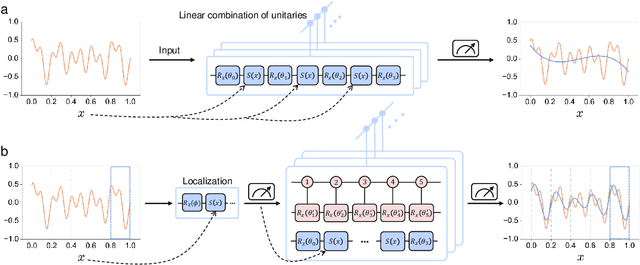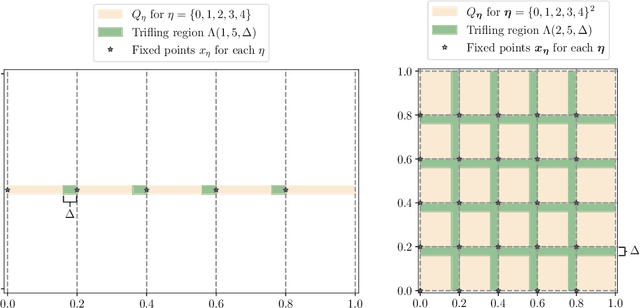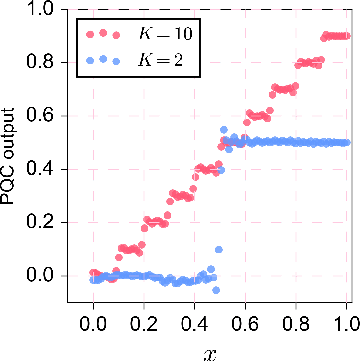Jerry Zhijian Yang
Provable Diffusion Posterior Sampling for Bayesian Inversion
Dec 08, 2025Abstract:This paper proposes a novel diffusion-based posterior sampling method within a plug-and-play (PnP) framework. Our approach constructs a probability transport from an easy-to-sample terminal distribution to the target posterior, using a warm-start strategy to initialize the particles. To approximate the posterior score, we develop a Monte Carlo estimator in which particles are generated using Langevin dynamics, avoiding the heuristic approximations commonly used in prior work. The score governing the Langevin dynamics is learned from data, enabling the model to capture rich structural features of the underlying prior distribution. On the theoretical side, we provide non-asymptotic error bounds, showing that the method converges even for complex, multi-modal target posterior distributions. These bounds explicitly quantify the errors arising from posterior score estimation, the warm-start initialization, and the posterior sampling procedure. Our analysis further clarifies how the prior score-matching error and the condition number of the Bayesian inverse problem influence overall performance. Finally, we present numerical experiments demonstrating the effectiveness of the proposed method across a range of inverse problems.
CRPE: Expanding The Reasoning Capability of Large Language Model for Code Generation
May 15, 2025Abstract:We introduce CRPE (Code Reasoning Process Enhancer), an innovative three-stage framework for data synthesis and model training that advances the development of sophisticated code reasoning capabilities in large language models (LLMs). Building upon existing system-1 models, CRPE addresses the fundamental challenge of enhancing LLMs' analytical and logical processing in code generation tasks. Our framework presents a methodologically rigorous yet implementable approach to cultivating advanced code reasoning abilities in language models. Through the implementation of CRPE, we successfully develop an enhanced COT-Coder that demonstrates marked improvements in code generation tasks. Evaluation results on LiveCodeBench (20240701-20240901) demonstrate that our COT-Coder-7B-StepDPO, derived from Qwen2.5-Coder-7B-Base, with a pass@1 accuracy of 21.88, exceeds all models with similar or even larger sizes. Furthermore, our COT-Coder-32B-StepDPO, based on Qwen2.5-Coder-32B-Base, exhibits superior performance with a pass@1 accuracy of 35.08, outperforming GPT4O on the benchmark. Overall, CRPE represents a comprehensive, open-source method that encompasses the complete pipeline from instruction data acquisition through expert code reasoning data synthesis, culminating in an autonomous reasoning enhancement mechanism.
Nonlinear Assimilation with Score-based Sequential Langevin Sampling
Nov 20, 2024



Abstract:This paper presents a novel approach for nonlinear assimilation called score-based sequential Langevin sampling (SSLS) within a recursive Bayesian framework. SSLS decomposes the assimilation process into a sequence of prediction and update steps, utilizing dynamic models for prediction and observation data for updating via score-based Langevin Monte Carlo. An annealing strategy is incorporated to enhance convergence and facilitate multi-modal sampling. The convergence of SSLS in TV-distance is analyzed under certain conditions, providing insights into error behavior related to hyper-parameters. Numerical examples demonstrate its outstanding performance in high-dimensional and nonlinear scenarios, as well as in situations with sparse or partial measurements. Furthermore, SSLS effectively quantifies the uncertainty associated with the estimated states, highlighting its potential for error calibration.
Deep Transfer Learning: Model Framework and Error Analysis
Oct 12, 2024Abstract:This paper presents a framework for deep transfer learning, which aims to leverage information from multi-domain upstream data with a large number of samples $n$ to a single-domain downstream task with a considerably smaller number of samples $m$, where $m \ll n$, in order to enhance performance on downstream task. Our framework has several intriguing features. First, it allows the existence of both shared and specific features among multi-domain data and provides a framework for automatic identification, achieving precise transfer and utilization of information. Second, our model framework explicitly indicates the upstream features that contribute to downstream tasks, establishing a relationship between upstream domains and downstream tasks, thereby enhancing interpretability. Error analysis demonstrates that the transfer under our framework can significantly improve the convergence rate for learning Lipschitz functions in downstream supervised tasks, reducing it from $\tilde{O}(m^{-\frac{1}{2(d+2)}}+n^{-\frac{1}{2(d+2)}})$ ("no transfer") to $\tilde{O}(m^{-\frac{1}{2(d^*+3)}} + n^{-\frac{1}{2(d+2)}})$ ("partial transfer"), and even to $\tilde{O}(m^{-1/2}+n^{-\frac{1}{2(d+2)}})$ ("complete transfer"), where $d^* \ll d$ and $d$ is the dimension of the observed data. Our theoretical findings are substantiated by empirical experiments conducted on image classification datasets, along with a regression dataset.
Unsupervised Transfer Learning via Adversarial Contrastive Training
Aug 16, 2024Abstract:Learning a data representation for downstream supervised learning tasks under unlabeled scenario is both critical and challenging. In this paper, we propose a novel unsupervised transfer learning approach using adversarial contrastive training (ACT). Our experimental results demonstrate outstanding classification accuracy with both fine-tuned linear probe and K-NN protocol across various datasets, showing competitiveness with existing state-of-the-art self-supervised learning methods. Moreover, we provide an end-to-end theoretical guarantee for downstream classification tasks in a misspecified, over-parameterized setting, highlighting how a large amount of unlabeled data contributes to prediction accuracy. Our theoretical findings suggest that the testing error of downstream tasks depends solely on the efficiency of data augmentation used in ACT when the unlabeled sample size is sufficiently large. This offers a theoretical understanding of learning downstream tasks with a small sample size.
DRM Revisited: A Complete Error Analysis
Jul 12, 2024Abstract:In this work, we address a foundational question in the theoretical analysis of the Deep Ritz Method (DRM) under the over-parameteriztion regime: Given a target precision level, how can one determine the appropriate number of training samples, the key architectural parameters of the neural networks, the step size for the projected gradient descent optimization procedure, and the requisite number of iterations, such that the output of the gradient descent process closely approximates the true solution of the underlying partial differential equation to the specified precision?
Characteristic Learning for Provable One Step Generation
May 09, 2024Abstract:We propose the characteristic generator, a novel one-step generative model that combines the efficiency of sampling in Generative Adversarial Networks (GANs) with the stable performance of flow-based models. Our model is driven by characteristics, along which the probability density transport can be described by ordinary differential equations (ODEs). Specifically, We estimate the velocity field through nonparametric regression and utilize Euler method to solve the probability flow ODE, generating a series of discrete approximations to the characteristics. We then use a deep neural network to fit these characteristics, ensuring a one-step mapping that effectively pushes the prior distribution towards the target distribution. In the theoretical aspect, we analyze the errors in velocity matching, Euler discretization, and characteristic fitting to establish a non-asymptotic convergence rate for the characteristic generator in 2-Wasserstein distance. To the best of our knowledge, this is the first thorough analysis for simulation-free one step generative models. Additionally, our analysis refines the error analysis of flow-based generative models in prior works. We apply our method on both synthetic and real datasets, and the results demonstrate that the characteristic generator achieves high generation quality with just a single evaluation of neural network.
Deep Conditional Generative Learning: Model and Error Analysis
Feb 02, 2024Abstract:We introduce an Ordinary Differential Equation (ODE) based deep generative method for learning a conditional distribution, named the Conditional Follmer Flow. Starting from a standard Gaussian distribution, the proposed flow could efficiently transform it into the target conditional distribution at time 1. For effective implementation, we discretize the flow with Euler's method where we estimate the velocity field nonparametrically using a deep neural network. Furthermore, we derive a non-asymptotic convergence rate in the Wasserstein distance between the distribution of the learned samples and the target distribution, providing the first comprehensive end-to-end error analysis for conditional distribution learning via ODE flow. Our numerical experiments showcase its effectiveness across a range of scenarios, from standard nonparametric conditional density estimation problems to more intricate challenges involving image data, illustrating its superiority over various existing conditional density estimation methods.
Semi-Supervised Deep Sobolev Regression: Estimation, Variable Selection and Beyond
Jan 09, 2024Abstract:We propose SDORE, a semi-supervised deep Sobolev regressor, for the nonparametric estimation of the underlying regression function and its gradient. SDORE employs deep neural networks to minimize empirical risk with gradient norm regularization, allowing computation of the gradient norm on unlabeled data. We conduct a comprehensive analysis of the convergence rates of SDORE and establish a minimax optimal rate for the regression function. Crucially, we also derive a convergence rate for the associated plug-in gradient estimator, even in the presence of significant domain shift. These theoretical findings offer valuable prior guidance for selecting regularization parameters and determining the size of the neural network, while showcasing the provable advantage of leveraging unlabeled data in semi-supervised learning. To the best of our knowledge, SDORE is the first provable neural network-based approach that simultaneously estimates the regression function and its gradient, with diverse applications including nonparametric variable selection and inverse problems. The effectiveness of SDORE is validated through an extensive range of numerical simulations and real data analysis.
Provable Advantage of Parameterized Quantum Circuit in Function Approximation
Oct 11, 2023



Abstract:Understanding the power of parameterized quantum circuits (PQCs) in accomplishing machine learning tasks is one of the most important questions in quantum machine learning. In this paper, we analyze the expressivity of PQCs through the lens of function approximation. Previously established universal approximation theorems for PQCs are mainly nonconstructive, leading us to the following question: How large do the PQCs need to be to approximate the target function up to a given error? We exhibit explicit constructions of data re-uploading PQCs for approximating continuous and smooth functions and establish quantitative approximation error bounds in terms of the width, the depth and the number of trainable parameters of the PQCs. To achieve this, we utilize techniques from quantum signal processing and linear combinations of unitaries to construct PQCs that implement multivariate polynomials. We implement global and local approximation techniques using Bernstein polynomials and local Taylor expansion and analyze their performances in the quantum setting. We also compare our proposed PQCs to nearly optimal deep neural networks in approximating high-dimensional smooth functions, showing that the ratio between model sizes of PQC and deep neural networks is exponentially small with respect to the input dimension. This suggests a potentially novel avenue for showcasing quantum advantages in quantum machine learning.
 Add to Chrome
Add to Chrome Add to Firefox
Add to Firefox Add to Edge
Add to Edge